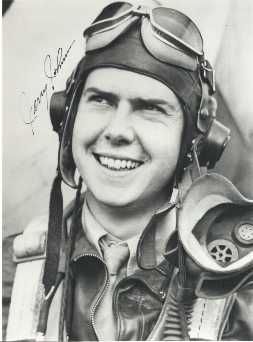Major Gerald W. Johnson
![]()
 Gerald Walter Johnson was born on July 10, 1919 in
Owenton, Kentucky. He left college in September 1941 to enter the aviation cadet training
program to become a Army Air Corps pilot. He received his pilots wings and was
commissioned as a second lieutenant in April 1942 at Ellington Field, Texas.
Gerald Walter Johnson was born on July 10, 1919 in
Owenton, Kentucky. He left college in September 1941 to enter the aviation cadet training
program to become a Army Air Corps pilot. He received his pilots wings and was
commissioned as a second lieutenant in April 1942 at Ellington Field, Texas.
Johnson was then assigned to the 56th Fighter Group at Mitchell Field, New York. He trained in the P-36, P-38, P-39 and the P-40. His squadron was transferred to Bridgeport, Connecticut where they were to receive the first P-47s delivered to a tactical unit. The group was sent to England and stationed at Kings Cliffe which was a new war time airfield still under construction in January 1943. In April 1943 the group was transferred to Horsham St. Faith which was located near the city of Norwich.
Johnson’s first combat mission was also the first mission of the 56th Fighter Group which was a fighter sweep over the western border of Belgium and France. Gerald flew wing for their commander, Colonel Hub Zemke. Johnson experienced his first aerial combat by damaging a Fw 190 on May 14,1943 northeast of Antwerp.
Johnson claimed his first aerial victory on June 26th by downing a Fw 190 north of Dieppe. In early August Gerald claimed two Bf 109’s and was promoted to Captain on August 10, 1943. He then shared in the downing of a Bf 110 on the 17th and downed another Bf 109 on the 19th. Johnson became the group’s first ace on October 10th with the downing of a Bf 110 and a Bf 210 in a battle north of Munster.
Johnson was sent to the 360th Fighter Squadron to help train the new group with his combat experiences. While working with the 360th Johnson claimed another aerial victory of a Fw 190 on January 24,1944. Johnson returned to the 56th Fighter Group to become commander of the 63rd Fighter Squadron scoring seven more aerial victories.
On March 27th 1944, Johnson was flying escort for bombers and after their bomb run, Johnson led his fighters down to look for targets of opportunity. He spotted a freight train and descended with his guns ripping into the rolling stock. Explosions rocked the train as he pulled up. Looking back Gerald saw that his men were getting devastating strikes as well.
Johnson's aircraft was hit by antiaircraft fire striking his engine knocking it out completely. Flying at only 200 feet off the ground, he pulled up over the train and headed for a group of trees. The plane was coming down and he fought the controls to keep the aircraft stable. The heavy P-47 mushed down into the tops of the trees and came out over a plowed field where it hit and skidded to a stop. Gerald was captured and held as a POW for the duration of the war until he was liberated in May 1945.
Johnson returned to the 56th Fighter Group at Selfridge Field Michigan where he commanded the 62nd Fighter Squadron. He chose to stay in the Air Corp thought the transition to the new Air Force continuing his collage education. He was promoted to brigadier general on November 1, 1965. He later commanded three air divisions as Lieutenant General and was Commander of the Eight Air Force during the last three years of the Viet Nam War.
Johnson was serving as Inspector General of the Air Force when he retired in September 1974.
Johnson was credited with 18 ½ aerial victories, one probable, and 4 ½ damaged. He earned the Distinguished Service Cross, Distinguished Service Medal with one Oak Leaf Cluster Legion of Merit with two Oak Leaf Clusters, Distinguished Flying Cross with 4 Oak Leaf Clusters, Bronze Star, Air Medal with 4 OLCs, Air Force and Army Commendation Medals and the French Croix De Guerre with Silver Star.